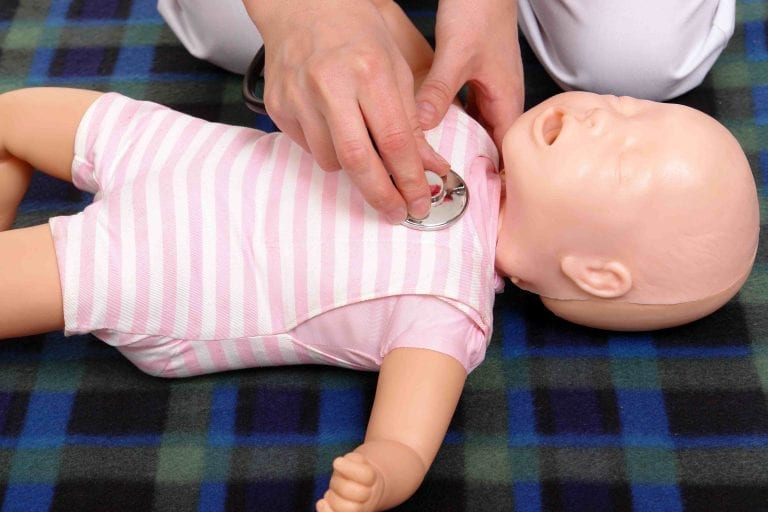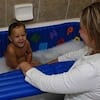Do you know what to do when your baby is choking?
You may be horrified at the thought of having to perform life-saving skills on your own baby if baby is choking, but fact is there’s a small risk that cardiac arrest can occur if your baby ever chokes on an object.
Unlike adults, cardiac arrest in infants almost always begins with respiratory arrest from a blocked airway. As soon as your baby is old enough to grab an object and bring it to his mouth, he’s at risk for choking on toys or any tiny item that can block his airway.
Many parents take a basic CPR course from a local hospital or Red Cross. Here’s a basic guide on how to prevent choking, react when your child is choking, and a review of the main steps you would learn and practice in a CPR course.
Prevent Infant Choking
- Check labels and packaging on new toys to ensure they’re baby-safe
- Always check play areas for small objects, especially under furniture
- Remind family members to pick up dropped items (coins, pens, paperclips, etc.)
- Keep trash out of reach
- Don’t leave unsafe items within baby’s reach
- Periodically check toys and baby furniture for broken parts
- Never let baby play with or chew on balloons, especially rubber ones
- Follow safe eating guidelines for 1st foods and never leave baby unattended at meal or snack time
- Discourage baby from playing or talking with food in his mouth
- Always feed baby while he is sitting
CPR FAQs
What is CPR?
Cardiopulmonary resuscitation. If you’re trained in CPR, you have the skills to compress a person’s heart (creating a “heartbeat”) and blow air into a person’s lungs (creating “breaths”) in the event of a heart attack. For the average person, CPR is a way to keep a person alive until healthcare professionals can take over.
Why should I learn CPR when I can call 911?
Research shows that with cardiac or respiratory arrest, the first few minutes are critical to survival. Beginning CPR immediately after arrest saves lives!
Do I have to take a class?
Ideally every new parent should know how to perform basic infant CPR. You can sign up for a CPR class, take an online course, take infant CPR training through your local hospital (where available) or purchase an instructional video. If you choose an online course or purchase a DVD, see if you can arrange to practice your skills under the guidance of a CPR instructor.
How do I find a CPR class?
Two organizations that have long histories of providing excellent research-based classes are American Heart Association (AHA) and American Red Cross (ARC). Both have courses for non-healthcare professionals. Check their websites or contact your local healthcare facility or fire department to find a class.
Are all the courses and instructional materials that I can find on my computer search OK to use?
No. Be sure to look for instructional information that follows the current 2015 AHA guidelines. Protocols change every few years based on current research. One example: You should now start compressions 1st during initial resuscitation instead of breaths, a change made in 2010. You should be recertified every 2 years.
What to Do If Your Baby Is Choking (Infants 0-12 months old)
| Step 1 | If your baby cannot cry or cough, go to Step 2 |
| Step 2 [image of parent performing back blow] | Give 5 back blows:
· Turn baby head down and place his stomach on your forearm or thigh with his head lower than the rest of is body · With one hand, hold baby’s jaw, and with the heel of the other hand, slap the baby firmly between the shoulder blades 5 times · If this fails, go to Step 3 |
| Step 3 [image of parent performing chest thrust] | Give 5 chest thrusts:
· Rotate baby face up again,using one hand to support the head · With your other hand, place 2 or 3 fingers in the center of the chest slightly below the nipple line and compress the chest rapidly and firmly 5 times · If this fails, go to Step 4 |
| Step 4 | Keep repeating steps 2 and 3 until the item is dislodged from the airway or the baby becomes unconscious.
· If baby becomes unconscious, begin CPR protocol · Ifat any time you see an object in baby’s mouth, remove it · Never put your fingers down baby’s throat as this could lodge the item even more firmly |
Basic Steps in CPR for Infants 0-12 months old
| Step 1[Image of parent shouting and stimulating bottom of foot, not on flat, firm surface] | Shout & tap: Shout and gently tap the baby’s shoulder or the bottom of his foot. If there is no response and no breathing, go to step 2. | |
| Step 2[image of parent yelling for help] | Yell for help: If there is another person nearby, ask them to call 911. If you’re alone, don’t baby to call or get help until you have completed 2 minutes of CPR. Tthe first few minutes of CPR are crucial to recovery. | |
| Step 3[Image of parent placing infant on floor or table top] | Move baby to flat, firm surface like a table top or the floor(a crib or changing pad is not firm enough) and lay him on his back. | |
| Step 4[image of parent using 2 fingers of one hand for compressions and the other hand gently stabilizing the baby’s head just above the forehead] | Give 30 compressions: Place 2 fingers on the middle of the chest just below the nipple line. Compress the chest about 1 ½ inches deep. Compressions must be given very rapidly (100-120 per minute or almost 2 compressions per second). | |
| Step 5[image of parent with one hand pulling up the chin and the other hand placed just above the baby’s forehead. Mother’s head should be close to baby’s and tilted as if listening for baby’s breathing.] | Open baby’s airway: Gently tilt baby’s chin upward to lengthen his airway. With one hand on baby’s head and the other on his chin, recheck see if the baby is breathing. Only take a few seconds to do this! If there is no breathing or abnormal breathing, go to step 6. | |
| Step 6[image of parent with mouth over the baby’s mouth and nose. One hand is on the chin and the other is on the head, as in step 5,] | Give 2 gentle breaths: Cover the baby’s nose and mouth with your mouth and blow a puff of air into the baby. His chest should rise gently with each breath. If it doesn’t, reposition his head and try again. | |
| Step 7 | Continue alternating compressions and breaths (steps 5 and 6): If the baby shows signs of life (breathing on his own or crying), you may stop CPR, but observe closely until healthcare professionals arrive in case you need to restart CPR. |
Related articles








Comments are closed.